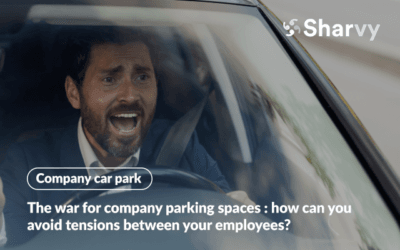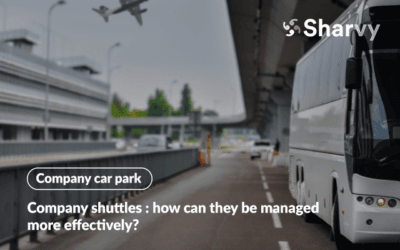Should you stay or move? For many companies, this question is no longer simply a logistical issue: it’s a strategic choice that impacts productivity, the attractiveness of talent & corporate culture.
In this context, the property strategy must take into account several parameters, including the famous 3-6-9 commercial lease, which is often restrictive, but decisive in any consideration of the future of the premises.
So, should you stay in your current premises to make the most of them? Or move to reinvent the way you work? And what if the key lay not so much in the location, but in the way you occupy it? With the rise of the flex office and desk booking tools, real estate strategy is entering a new era: one of data, modularity and collaboration.
Stay: a real estate strategy of continuity and optimisation.
Choosing to stay in your premises may seem the simplest solution, especially when a 3-6-9 commercial lease imposes long-term commitments. However, there’s nothing passive about this choice: if well thought through, it can become a real lever for performance and optimisation.
1. The advantages of not moving your business.
Staying on your premises may seem like a default choice, but it’s often a strategic decision full of common sense. If your 3-6-9 commercial lease commits you for several years, why not turn this constraint into an opportunity? With a little agility and creativity, your offices can once again become an asset rather than a hindrance.
By staying, you save your teams a time-consuming and costly move. They’ll keep their landmarks, their commute to work will remain unchanged, and productivity will remain intact. At a time when companies are undergoing one transformation after another, this stability can become a real factor of serenity and efficiency.
What’s more, your premises already represent a major investment. Rather than starting from scratch, you can :
- Renegotiate certain clauses in the lease to bring costs into line with your business reality.
- Reorganise your space to better meet your current needs: transform a meeting room into a collaborative space, reduce the number of fixed workstations and create modular areas.
- Avoid the hidden costs of moving: building work, transport, internal communications, loss of bearings, etc. These are all expenses that you can reinvest in your fit-out.
Finally, staying does not mean « immobilism ». On the contrary, it’s an opportunity to reinvent the way you occupy your premises. By adopting the flex office, for example, you can adapt your spaces to the real uses of your teams, reduce unused workstations & reallocate certain areas to more useful functions: collaboration, concentration or conviviality.
2. The limits of a conservative property strategy.
Staying on your premises is not always synonymous with efficiency, and not all companies face the same reality in this respect.
On the one hand, some companies find that their offices are partially empty several days a week. Hybrid working has changed habits: teams rotate, open spaces empty out, but rents remain unchanged. The result: under-utilised and expensive square metres.
On the other hand, some fast-growing companies are desperately short of space. Staff numbers are increasing and jobs are becoming scarcer, but premises are not keeping pace and the quality of life at work is suffering. Meeting rooms are full, quiet areas are disappearing, and concentration is becoming a real daily challenge.
Faced with these two opposing realities: too much unused space or not enough room to grow, the key often lies in flexibility. Implementing a more flexible organisation, such as reserving workstations, allows you to adjust the use of premises to the actual presence of your teams. It’s a practical way of optimising your square metres, without having to move or break your lease.
Another observation is that your workspaces are not always in tune with new ways of working. Too rigid, they struggle to keep up with today’s needs for concentration, collaboration and creativity. Without change, offices quickly become a hindrance to performance and cohesion.
Finally, staying at out of habit means taking another risk: sending out the wrong signal. Premises say a lot about a company’s culture. Unchanged offices can give the image of an organisation that stands still, whereas a reorganisation (even without moving) reflects a company that is adapting, moving and thinking about the future.
In the end, staying is not a passive choice, but a strategic decision. Provided you adjust and use the right tools to transform the constraint into a lever for efficiency.
Moving: a real estate strategy for transformation.
1. The benefits of this real-estate strategy.
First and foremost, a move offers a clean slate. It’s often the ideal time to realign your real estate strategy with the reality of hybrid working, as well as with the evolution of your workforce.
This change of framework allows you to intelligently resize your floor space and incorporate an appropriate expansion rate. For example, if 70% of your employees are present on average each day, there’s no need to maintain 100 fixed workstations: 70 are enough. This ratio, often referred to as the 0.7 expansion ratio, is an effective benchmark for hybrid environments.
It allows you to pool spaces, reduce property costs and, above all, free up square metres for areas with higher added value: collaborative spaces, concentration bubbles and convivial areas.
But this transition doesn’t happen overnight. To avoid disrupting your teams, it’s often a good idea to introduce desk-booking gradually, or even temporarily, after the move. This is a gentle way of introducing new practices, without upsetting habits.
A company move should therefore not be seen as an escape, but as an opportunity for thoughtful transformation. Once again, this requires the integration of a real property strategy and the right management tools, such as desk booking, to guarantee the flexibility and optimisation of space on a day-to-day basis.
2. The limits of this real-estate strategy.
Although moving opens up new prospects, it is still a demanding decision. It requires resources, time and real change management.
First of all, you need to consider the overall cost of the project: over and above the rent, a move involves expenditure that is often underestimated: fitting-out work, purchase of furniture, transfer costs, internal communication, and even HR support to ease the transition. These costs can weigh heavily in the short term, especially if the company does not immediately realise any gains in terms of surface area occupied.
Then there is the inevitable adjustment period. Changing location also means changing your points of reference. Even in a redesigned environment, your teams will need time to get to grips with the new space, understand the new organisation and find their feet again. Without support, this phase can lead to stress and a temporary drop in productivity.
The move also involves a degree of strategic risk. The wrong size (too big, too small, in the wrong location) can quickly turn an opportunity into a constraint. Hence the importance of basing every decision on accurate occupancy and footfall data before signing a new lease.
The move should therefore be seen as a lever for change, not a miracle solution.
Towards a hybrid, managed property strategy?
What if, in the end, the real question wasn’t: « should we keep or change our premises »? Rather, « how can they be used intelligently »? Because today, it’s no longer the surface area that counts, but the way in which it is used on a day-to-day basis.
Hybrid working has shaken things up. Offices are no longer full five days a week, and usage varies according to team, project & period. Against this backdrop, it no longer makes sense to continue blindly to manage your « spaces ».
And that’s precisely where desk booking changes the game.
You know exactly who is coming, when and where. Your employees can book their workstation in just a few clicks. For your part, you have concrete data on the occupancy rate, peak use and under-used areas.
This information changes everything: it allows you to manage your floor space at the right level.
You no longer need to make assumptions, you have a factual basis on which to make decisions. So you can :
- Resize your spaces according to actual usage.
- Identify areas that need to be transformed (collaboration, concentration, relaxation).
- Anticipate needs linked to growth and new practices.
In short, it’s a data-driven approach to office space that puts measurement and relevance back at the heart of real estate strategy.
In conclusion
Today, real estate strategy is not just a choice between the size of premises and the prestige of an address. True real estate performance is measured by adaptability and control over usage.
Successful companies don’t just occupy offices: they develop their space with their organisation, anticipating needs rather than reacting to constraints.
Thinking of real estate as a strategic lever means recognising that every decision (layout, use, location) has an impact on the way your teams work, collaborate and innovate. And it’s this ability to transform your offices that makes the difference between an organisation that stands still and one that can keep pace with its development and ambitions.
Do you have a question? Check out these FAQs!
How can we measure employees' actual satisfaction with workspaces?
In addition to traditional surveys, there are more detailed methods: qualitative studies, observations of workflows, discussion groups and monitoring of indirect usage indicators (unscheduled meetings, use of relaxation and collaboration areas). These data provide a more complete picture than simple one-off surveys, and can be used to guide precise, concrete choices.
How can we anticipate future needs without predicting the unpredictable?
Rather than trying to anticipate every change, it’s more effective to build flexible, modular spaces that can evolve according to activity, the number of employees and projects. The key is to combine realistic development scenarios with agile, modular solutions (implementing flex office, choosing removable partitions, etc.) that limit costs when adjustments are needed.
Which indicators can help to manage the effectiveness of spaces?
Beyond the simple occupation of square metres, several indicators are useful. These measures can be used to correct and adapt layouts on an ongoing basis:
- Office expansion rate.
- Reservation rate vs. utilisation rate (if applicable).
- Workstation turnover rate (if applicable).
- Utilisation rate of meeting rooms & collaboration areas.
- Average length of meetings.
- Utilisation rate of informal areas & « breakout spaces ».
- Average time spent per employee on site.
- Qualitative feedback from teams on comfort & functionality.
Want to find out more? Here are our latest articles!
Supervision of charging stations in companies : how to prevent breakdowns and anomalies?
Why is the supervision of charging stations essential for businesses? How can you prevent breakdowns and ensure their reliability? Focus.
The war for company parking spaces : how can you avoid tensions between your employees?
Company parking spaces : a real headache? Find out how to avoid tensions and put people’s minds at rest in this article!
Company shuttles : how can you optimise their management to reduce your carbon footprint?
How can you optimise the management of your company shuttles? What are the environmental issues involved? What are the benefits for your company?
Subscribe to our newsletter!
Resources
Contact us
+33 4 12 39 60 60







